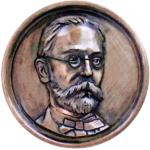W opracowaniu
Aktualny numer
Numery specjalne
Archiwum
O czasopiśmie
Redakcja
Rada Redakcyjna
Recenzenci
Instrukcja redakcyjna
Zasady etyki publikacyjnej
Zasady recenzowania
Ghostwriting
Prawa autorskie i polityka Open Access
Klauzula informacyjna RODO – dla autorów artykułów zgłoszonych do publikacji w kwartalniku „Komunikaty Mazursko-Warmińskie”
Kontakt
Cennik
PROJEKTY
Naprom, powiat Ostróda (Gross Nappern, Kr. Osterode). Wczesnośredniowieczne cmentarzysko w świetle danych archiwalnych
Data publikacji online: 08-05-2016
Data publikacji: 08-05-2016
KMW 2016;291(1):3-10
SŁOWA KLUCZOWE
wczesne średniowieczePrusowiepogranicze mazowiecko-pruskieobrządek pogrzebowycmentarzyskaarchiwaliaCarl Engel
DZIEDZINY
STRESZCZENIE
The cemetery discovered in the village of Naprom, Ostróda County (former Gross Nappern, Kr.
Osterode) is not known in the archaeological literature. Contemporary knowledge of the necropolis comes
from the article: Prussians in the early Middle Ages and the outline of their material culture. The content can
be inferred that the discovered site was a vast necropolis, within which a large number of sepulchral objects
were uncovered. Some information about the discovery can be found in the articles by C. Engel published in
the daily press in the 1930s. (Königsberger Stadtspiegel, Johannisburger Zeitung). During the archival inquiry
carried out in the Archäologisches Landesmuseum Schloss Gottdorf in Schleswig (the so-called Rudolf Grenz’s
files) and the Museum für Vor- und Frühgeschichte in Berlin (the archives of the former Prussia-Museum)
interesting unpublished materials concerning the burial ground in Gross Nappern were found. During his journey in Ostróda and Lidzbark county in 1931 Carl Engel carried out a trial excavation.
In the trench two cremation graves covered with stone constructions were discovered. The potsherds were
the only artifacts found in the graves (on the basis of the description these can be dated back to the 11th – 1st
half of 13th c.). The owner of the grounds, where the graves were discovered reported that in the vicinity of
the excavated graves there used to be a barrow (it was destroyed around 1905, and the stones from the mound
were used during the construction of the barn). That was the reason why C. Engel came back to the village of
Naprom to excavate the destroyed barrow.
REFERENCJE (6)
1.
Antoniewicz J., Prusowie we wczesnym średniowieczu i zarys ich kultury materialnej, w: Szkice z dziejów Pomorza. Pomorze średniowieczne, Warszawa 1958, ss. 121–159.
2.
Gaerte W., Tätigkeitsbericht der vorgeschichtlichen Abteilung des Prussia-Museums in Königsberg i. Pr. (pro 1931), Nachrichtenblatt für deutsche Vorzeit, 1931, Bd. 8, ss. 6–11.
3.
Engel C.,La Baume W., Erläuterungen zum Atlas des Ost- und Westpreusischen Landesgeschichte,Teil 1: Kulturen und Volker der Frühzeit im Preußenlande, Königsberg 1937.
4.
Wczesnohistoryczne cmentarzysko na Mazurach Pruskich, Z Otchłani Wieków, 1931, nr 6, z. 4–5,s. 71.
5.
Urbańczyk P., Archeologia etniczności – fikcja czy nadzieja, w: Archeologia w teorii i praktyce, pod red. A. Buko, P. Urbańczyka, Warszawa 2000, ss. 137–146.
6.
Werbart B., Kultura archeologiczna a tożsamość kulturowa – problemy synchronizacji, w: Archeologia w teorii i praktyce, Warszawa 2000, ss. 147–165.
Udostępnij
ARTYKUŁ POWIĄZANY
Przetwarzamy dane osobowe zbierane podczas odwiedzania serwisu. Realizacja funkcji pozyskiwania informacji o użytkownikach i ich zachowaniu odbywa się poprzez dobrowolnie wprowadzone w formularzach informacje oraz zapisywanie w urządzeniach końcowych plików cookies (tzw. ciasteczka). Dane, w tym pliki cookies, wykorzystywane są w celu realizacji usług, zapewnienia wygodnego korzystania ze strony oraz w celu monitorowania ruchu zgodnie z Polityką prywatności. Dane są także zbierane i przetwarzane przez narzędzie Google Analytics (więcej).
Możesz zmienić ustawienia cookies w swojej przeglądarce. Ograniczenie stosowania plików cookies w konfiguracji przeglądarki może wpłynąć na niektóre funkcjonalności dostępne na stronie.
Możesz zmienić ustawienia cookies w swojej przeglądarce. Ograniczenie stosowania plików cookies w konfiguracji przeglądarki może wpłynąć na niektóre funkcjonalności dostępne na stronie.




